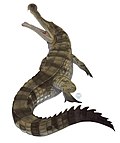| Neosuchia Temporal range: Early Jurassic - Recent, | |
|---|---|
 | |
| Crocodylus niloticus , a modern crocodylid | |
 | |
| Sarcosuchus imperator , a pholidosaurid from North Africa in the Early Cretaceous | |
| Scientific classification | |
| Kingdom: | Animalia |
| Phylum: | Chordata |
| Class: | Reptilia |
| Clade: | Archosauria |
| Clade: | Pseudosuchia |
| Clade: | Crocodylomorpha |
| Clade: | Metasuchia |
| Clade: | Neosuchia Benton & Clark, 1988 |
| Subgroups | |
| |
Neosuchia is a clade within Mesoeucrocodylia that includes all modern extant crocodilians and their closest fossil relatives. [1] It is defined as the most inclusive clade containing all crocodylomorphs more closely related to Crocodylus niloticus (the Nile Crocodile) than to Notosuchus terrestris . [2] Members of Neosuchia generally share a crocodilian-like bodyform adapted to freshwater aquatic life, as opposed to the terrestrial habits of more basal crocodylomorph groups. [3] The earliest neosuchian is suggested to be the Early Jurassic Calsoyasuchus , which lived during the Sinemurian and Pliensbachian stages in North America. It is often identified as a member of Goniopholididae, [4] though this is disputed, and the taxon may lie outside Neosuchia, which places the earliest records of the group in the Middle Jurassic. [3]







